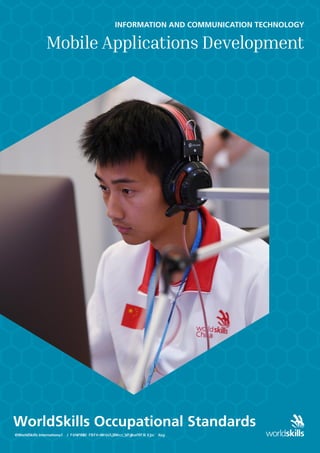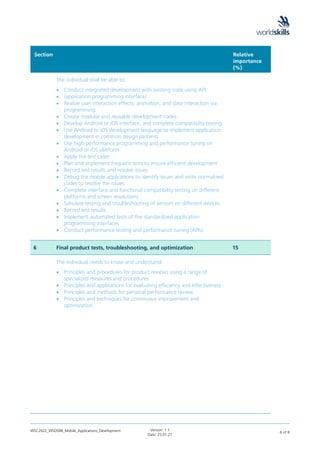Wsc2022 wsos08 mobile_applications_development
- 1. MANUFACTURING AND ENGINEERING TECHNOLOGY IT Software Solutions for Business INFORMATION AND COMMUNICATION TECHNOLOGY Mobile Applications Development WorldSkills Occupational Standards ┬®WorldSkills International 95%A9515A/QDKNGA#RRNKECVKQPUAGXGNQROGPV
- 2. WSC2022_WSOS08_Mobile_Applications_Development Version: 1.1 Date: 25.01.21 1 of 8 WorldSkills Occupational Standards (WSOS) General notes on the WSOS The WSOS specifies the knowledge, understanding, and specific skills that underpin international best practice in technical and vocational performance. It should reflect a shared global understanding of what the associated work role(s) or occupation(s) represent for industry and business (www.worldskills.org/WSOS). The skill competition is intended to reflect international best practice as described by the WSOS, and to the extent that it is able to. The Standard is therefore a guide to the required training and preparation for the skill competition. In the skill competition the assessment of knowledge and understanding will take place through the assessment of performance. There will only be separate tests of knowledge and understanding where there is an overwhelming reason for these. The Standard is divided into distinct sections with headings and reference numbers added. Each section is assigned a percentage of the total marks to indicate its relative importance within the Standards. This is often referred to as the ŌĆ£weightingŌĆØ. The sum of all the percentage marks is 100. The weightings determine the distribution of marks within the Marking Scheme. Through the Test Project, the Marking Scheme will assess only those skills that are set out in the Standards Specification. They will reflect the Standards as comprehensively as possible within the constraints of the skill competition. The Marking Scheme will follow the allocation of marks within the Standards to the extent practically possible. A variation of up to five percent is allowed, provided that this does not distort the weightings assigned by the Standards.
- 3. WSC2022_WSOS08_Mobile_Applications_Development Version: 1.1 Date: 25.01.21 2 of 8 WorldSkills Occupational Standards Section Relative importance (%) 1 Work organization and management 5 The individual needs to know and understand: ŌĆó Principles, regulations and standards relating to safe working space and practices ŌĆó The importance of personal integrity and ethical standards ŌĆó Obligations to clients and users for the security of their data, information, and other types of property ŌĆó The need for self-appraisal relative to work demands and expectations ŌĆó Options for filling gaps in personal expertise relative to the work in hand ŌĆó The nature of contracts and agreements, and the rights and obligations that accompany them ŌĆó The availability of the resources required to fulfil clientsŌĆÖ requirements ŌĆó Good practice in relation to the acquisition, use, storage and maintenance of equipment and materials ŌĆó Techniques and options for work planning, scheduling and prioritization ŌĆó The importance of methodical work practice, including attention to detail, accuracy, and checking ŌĆó The importance of continuing and proactive professional development The individual shall be able to: ŌĆó Organize and maintain a safe and efficient workspace ŌĆó Maintain the integrity and confidentiality of systems, data, information and documents at all times ŌĆó Acquire, use, maintain, and store all equipment and materials to ensure optimal and sustained performance ŌĆó Read, appraise and clarify the rights and obligations tied to formal documentation of all kinds ŌĆó Review opportunities, expectations and offers, relative to personal professional capacity, in order to make open, informed choices ŌĆó Select, use and keep up to date selected measures for work planning, scheduling and prioritization ŌĆó Check and ensure that all specific resources are available for the work in hand ŌĆó Meet or enhance the satisfaction of clients and others through self- knowledge, expectation management, and personal efficiency and effectiveness ŌĆó Proactively grow personal expertise through research and, professional development.
- 4. WSC2022_WSOS08_Mobile_Applications_Development Version: 1.1 Date: 25.01.21 3 of 8 Section Relative importance (%) 2 Business, communication, and interpersonal skills for clients and project fulfilment 5 The individual needs to know and understand: ŌĆó Principles and applications of costing, budgeting and charging, relative to market factors ŌĆó The importance of speaking, listening, and writing skills to communicate with clients, colleagues and others ŌĆó Communication and behavioural techniques for preventing and, if necessary, resolving misunderstandings ŌĆó The need for discretion and confidentiality when dealing with clients and others ŌĆó The importance of establishing and maintaining productive working relationships with colleagues, and team members where relevant ŌĆó Conventions and protocols for software documentation ŌĆó The principles and applications of record keeping and report writing in relation to the entire work process, from receiving a brief to completion and handover of the agreed work. The individual shall be able to: ŌĆó Prepare for meetings with clients and associates ŌĆó Gather, clarify, and confirm client requirements ŌĆó Receive, clarify, and interpret briefs and specifications ŌĆó Offer and discuss options and alternatives ŌĆó Discuss time, costs and fees with client, to reach mutual acceptance ŌĆó Document and sort out customer needs ŌĆó Use project management skills and techniques to make the most of workplace organization and resources ŌĆó Follow instructions from available guidance documentation ŌĆó Record each stage of work development ŌĆó Keep client regularly updated on progress ŌĆó Present proposed and final software solutions ŌĆó Prioritize and schedule tasks ŌĆó Allocate resources to tasks
- 5. WSC2022_WSOS08_Mobile_Applications_Development Version: 1.1 Date: 25.01.21 4 of 8 Section Relative importance (%) 3 Initial planning, design, and test framework 10 The individual needs to know and understand: ŌĆó Characteristics and advantages of various development platforms (e.g. iOS, Android) ŌĆó The behaviours of mobile application users ŌĆó Impact of the features on mobile application products (e.g. size and various parameters) ŌĆó Principles and applications of design thinking processes ŌĆó The design methods of user interface (UI) ŌĆó The design methods of user experience (UE/UX) ŌĆó Principles and applications of framework design ŌĆó The means of selecting ŌĆ£what works bestŌĆØ ŌĆó Principles and applications for flow diagrams ŌĆó The principles and applications of version control ŌĆó The design of test plans and procedures ŌĆó A range of testing methods and tools (e.g. unit test, functional test, performance test, etc.) ŌĆó Specifications for writing codes ŌĆó Methods for writing detection program documentation. The individual shall be able to: ŌĆó Choose the most suitable development platforms ŌĆó Use UI design software such as Adobe XD, Sketch and Sigma ŌĆó Conduct prototype and visual design on the application user interface (UI) ŌĆó Use UI application specifications of iOS or Android systems ŌĆó Produce user experience (UE) documentation for applications ŌĆó Produce standardized documentation of applicationsŌĆÖ brand image, following clientsŌĆÖ brand guidelines ŌĆó Plan and design marketing solutions for mobile applications store ŌĆó Plan test cases ŌĆó design specifications for writing test reports.
- 6. WSC2022_WSOS08_Mobile_Applications_Development Version: 1.1 Date: 25.01.21 5 of 8 Section Relative importance (%) 4 Systems architecture planning 40 The individual needs to know and understand: ŌĆó Principles and applications for creating systems architecture ŌĆó The interaction of platforms and systems architecture ŌĆó The basis for the choice of Flutter or React Native ŌĆó The basis for selecting modules provided by the web services ŌĆó Mobile platform system mechanism (Android or iOS) ŌĆó SDK architecture and its usage ŌĆó Application code frameworks ŌĆó Commonly used underlying libraries ŌĆó Programme compatibility on various terminal devices ŌĆó Web service, Socket, http(s) protocols ŌĆó Database design, SQL query language ŌĆó RESTful API design, XML and JSON data format ŌĆó Architecture design, development, testing, tuning and other technologies, and the use of related tools ŌĆó Basic principles and common design patterns of object-oriented design ŌĆó Industry trends and developments, including new platforms, development languages, protocols, and technologies The individual shall be able to: ŌĆó Design the interface based on visual design drafts ŌĆó Review, select and use open source libraries and frameworks (e.g. using Google Map) ŌĆó Develop corresponding functions according to the features of different mobile devices ŌĆó Obtain the mobile terminal deviceŌĆÖs performance parameters from mobile applications ŌĆó Implement visualized data statistical analysis and screening in mobile applications ŌĆó Handle common issues caused by servers, databases, etc. 5 Implementation and product development 10 The individual needs to know and understand: ŌĆó The coding specifications and importance of mobile application codes ŌĆó Capability of smart terminals such as cameras, GPS, gyroscopes, accelerometers, and Bluetooth ŌĆó Visualized data presentation skills (e.g. pie charts, histograms, line graphs, etc.) ŌĆó Prompted issues from the system and intelligent terminals ŌĆó Principle of 2D and 3D design of animation ŌĆó Mathematical aptitude ŌĆó Mobile applicationsŌĆÖ fault-finding skills. ŌĆó Encryption, decryption, signature, etc. of data communication between user terminal and server
- 7. WSC2022_WSOS08_Mobile_Applications_Development Version: 1.1 Date: 25.01.21 6 of 8 Section Relative importance (%) The individual shall be able to: ŌĆó Conduct integrated development with existing code using API ŌĆó (application programming interface) ŌĆó Realize user interaction effects, animation, and data interaction via programming ŌĆó Create modular and reusable development codes ŌĆó Develop Android or iOS interface, and complete compatibility testing ŌĆó Use Android or iOS development language to implement application development in common design patterns ŌĆó Use high-performance programming and performance tuning on Android or iOS platform ŌĆó Apply the test cases ŌĆó Plan and implement frequent tests to ensure efficient development ŌĆó Record test results and resolve issues ŌĆó Debug the mobile applications to identify issues and write normalized codes to resolve the issues ŌĆó Complete interface and functional compatibility testing on different platforms and screen resolutions ŌĆó Simulate testing and troubleshooting of sensors on different devices ŌĆó Record test results ŌĆó Implement automated tests of the standardized application programming interfaces ŌĆó Conduct performance testing and performance tuning (APIs). 6 Final product tests, troubleshooting, and optimization 15 The individual needs to know and understand: ŌĆó Principles and procedures for product reviews using a range of specialized measures and procedures ŌĆó Principles and applications for evaluating efficiency and effectiveness ŌĆó Principles and methods for personal performance review ŌĆó Principles and techniques for continuous improvement and optimization.
- 8. WSC2022_WSOS08_Mobile_Applications_Development Version: 1.1 Date: 25.01.21 7 of 8 Section Relative importance (%) The individual shall be able to: ŌĆó Complete all tests to verify functionality ŌĆó Bring together all aspects of the project ŌĆó Analyse and evaluate each stage of the project, relative to ŌĆó The clientŌĆÖs specification ŌĆó The quality of the user experience ŌĆó ring together test results to produce a final report ŌĆó Evaluate own performance relative to the given brief ŌĆó Review the completed project in order to ask ŌĆ£how would I move this on?ŌĆØ ŌĆ£How would I take this to the next stage?ŌĆØ ŌĆó Prepare and present proposals for optimization to line managers and/or clients
- 9. WSC2022_WSOS08_Mobile_Applications_Development Version: 1.1 Date: 25.01.21 8 of 8 References for industry consultation WorldSkills is committed to ensuring that the WorldSkills Occupational Standards fully reflect the dynamism of internationally recognized best practice in industry and business. To do this WorldSkills approaches a number of organizations across the world that can offer feedback on the draft Description of the Associated Role and WorldSkills Occupational Standards on a two-yearly cycle. In parallel to this, WSI consults three international occupational classifications and databases: ŌĆó ISCO-08: (http://www.ilo.org/public/english/bureau/stat/isco/isco08/) ŌĆó ESCO: (https://ec.europa.eu/esco/portal/home ) ŌĆó O*NET OnLine (www.onetonline.org/) There were no responses to the requests for feedback this cycle.









